Lugares de interés (POIs) del Mapa
0: Yongdusan Park (?????)
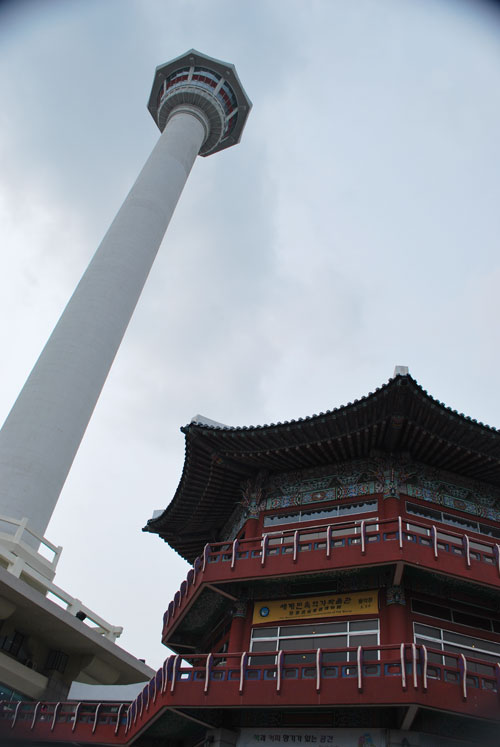
Yongdusan Park is the South Korean port city of Busan's most popular park. The site of several statues and two small museums, the park's most notable feature is the 120-meter high Busan Tower, which offers panoramic views of downtown Busan.
Más sobre Yongdusan Park (?????)
1: Jogyesa Temple (???)
Read more information on the Discovering Korea blog here.
Más sobre Jogyesa Temple (???)
2: Jonggak Intersection
Read more information on the Discovering Korea blog here.
Más sobre Jonggak Intersection
3: Dongguk University Station (?????)
Read more information on the Discovering Korea blog here.
Más sobre Dongguk University Station (?????)
4: Insa-dong (???)
Read more information on the Discovering Korea blog here.
Más sobre Insa-dong (???)
5: 2009 Lotus Lantern Festival Parade Route
The Route for the 2009 Lotus Lantern Festival's parade route
Read more information on the Discovering Korea blog here.
Más sobre 2009 Lotus Lantern Festival Parade Route
6: Bongeunsa Temple (???)
Bongeunsa (???) is a major temple of Korean Buddhism, located across the street from the COEX shopping center.
Read more information on the Discovering Korea blog here.
Más sobre Bongeunsa Temple (???)
7: Seonyudo Island (???)

Although South Korea has industrialized remarkably over the past several decades, there are still unspoiled corners where nature remains in charge. One such place is Seonyu Island (???), which is located off the coast of North Jeolla Province.
Más sobre Seonyudo Island (???)
8: The Flying Spoon
Read the DiscoveringKorea.com review here.
Más sobre The Flying Spoon
9: Egg and Spoon Race
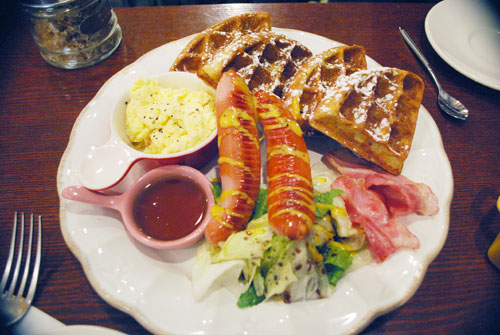
Más sobre Egg and Spoon Race
10: D'Avant
Read the DiscoveringKorea.com review here.
Más sobre D'Avant
11: The Parkview at The Shilla
Read the DiscoveringKorea.com review here.
Más sobre The Parkview at The Shilla
12: Butterfinger Pancakes

Read the DiscoveringKorea.com review here.
Más sobre Butterfinger Pancakes
13: Hampyeong Butterfly Festival (???????)
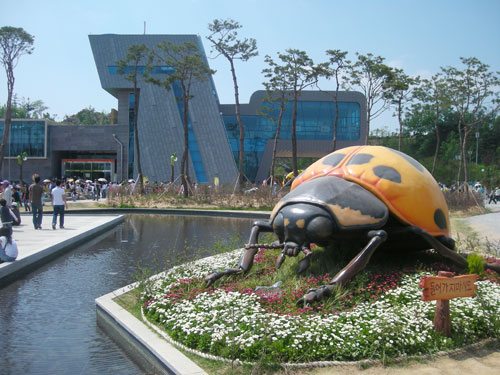
Hampyeong is a city in South Jeolla Province best known for its annual butterfly and insect festival.
Más sobre Hampyeong Butterfly Festival (???????)
14: Beopjusa Temple (???)

Beopjusa Temple is a gorgeous Buddhist temple located on Songnisan Mountain in North Chungcheong Province. The temple complex is best known for the five-story Palsangjeon and a 33-meter-high golden Buddha.
Más sobre Beopjusa Temple (???)
15: Cheongdo Bullfighting Festival (???????)

Cheongdo is a small city located in North Gyeongsang Province famous for its annual bullfighting festival.
Read the post on DiscoveringKorea.com.
Más sobre Cheongdo Bullfighting Festival (???????)
16: South Korea National Assembly
South Korea's parliament, the National Assembly, meets on Seoul's Yeouido Island.
Más sobre South Korea National Assembly
17: Yeouiseo-ro Street (????)
| From Yeouido Island (???) |
Más sobre Yeouiseo-ro Street (????)
18: 63 Building (????)
| From Yeouido Island (???) |
Más sobre 63 Building (????)
19: Yeouido Park (??? ??)

Yeouido Park is a large public playground that bisects Yeouido Island in central Seoul. The park features bike and walking paths, a large paved area for sports and bicycle rental facilities.
Más sobre Yeouido Park (??? ??)
20: Incheon International Airport (??????)
The primary international airport serving Seoul is located in Incheon. Incheon International Airport has been ranked the world's best for the past three years. The convenient AREX Airport Express train whisks passengers from Incheon to Gimpo International Airport.
Más sobre Incheon International Airport (??????)
21: Gimpo International Airport (??????)
Gimpo International Airport in western Seoul operates primarily domestic flights, as well as some transit to destinations in Japan and China. The convenient AREX Airport Express train whisks passengers from Gimpo to Incheon International Airport. Gimpo is connected to the Seoul Metro system via line 5.
Más sobre Gimpo International Airport (??????)
22: Jinhae Naval Port Festival (??????)
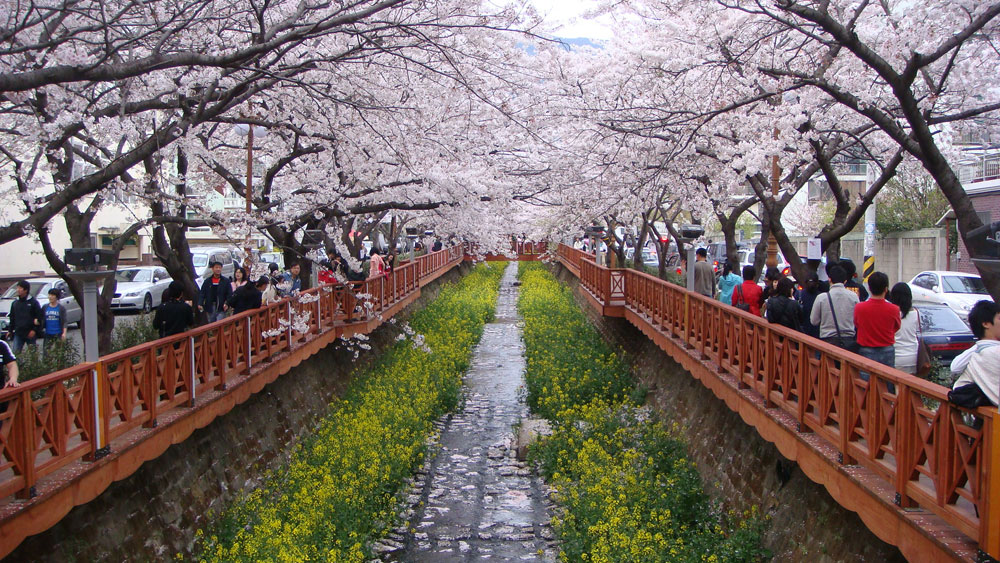
Better known as its annual cherry blossom festival, the South Gyeongsang Province city of Jinhae hosts its annual Naval Port Festival each spring. The city boasts the world's largest concentration of flowering cherry trees.
Read the post on DiscoveringKorea.com.
Más sobre Jinhae Naval Port Festival (??????)
23: Dosan Seowon Confucian Academy (????)
The city of Andong in North Gyeongsang Province is home to Dosan Seowon, Korea's largest and most famous Confucian academy. First built in 1574, the school was built to enshrine the memorial tablet of Yi Hwang, one of Korea's most celebrated philosophers.
Más sobre Dosan Seowon Confucian Academy (????)
24: Andong (??)
Read the post on DiscoveringKorea.com.
Más sobre Andong (??)
25: Ewha Woman's University (???????)
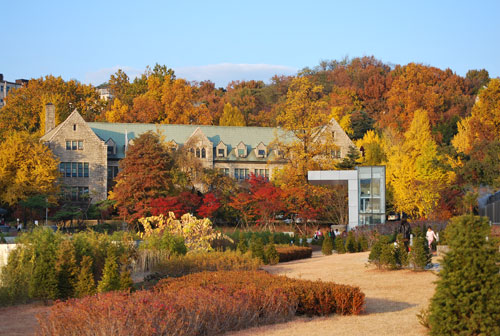
Más sobre Ewha Woman's University (???????)
26: Wedding Town
The area between Seoul Metro line 2's Edae and Ahyeon stations is known as "Wedding Town" for its scores of wedding dress shops. The neighborhood is located next to the all-female Ewha Woman's University.
Más sobre Wedding Town
27: Bongwonsa Temple (???)
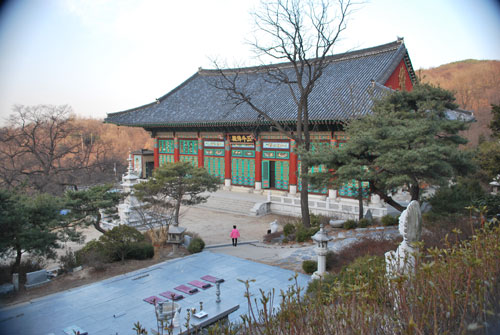
Bongwonsa is a beautiful Buddhist temple located on the slopes of An Mountain, which overlooks the Sinchon/Edae neighborhood campuses of Yonsei and Ewha Universities. Bongwonsa is the head temple of the Taego Order of Korean Buddhism, and is well-known for its reenactment of the Yeongsanjae Ceremony.
Más sobre Bongwonsa Temple (???)
28: Icheon Baeksa Sansuyu Blossom Festival
Read the spring festivals post on DiscoveringKorea.com.
Más sobre Icheon Baeksa Sansuyu Blossom Festival
29: Damyang Bamboo Festival
Read the spring festivals post on DiscoveringKorea.com.
Más sobre Damyang Bamboo Festival
30: Yakcheonsa Temple (???)

Yakcheonsa Temple on Jeju Island's southern coast is a massive Buddhist temple complex. Although it's painted in the Joseon Dynasty-style, the temple was built in the 1990s.
Más sobre Yakcheonsa Temple (???)
31: Jeongbang Waterfall (????)
Read the post on the DiscoveringKorea.com blog.
Más sobre Jeongbang Waterfall (????)
32: Songjeongmehyang Restaurant (????)
Ms. Lee's Songjeongmehyang (????) Restaurant serves a delicious roasted tilefish (????) and is conveniently located near the Jeongbang Waterfall.
Más sobre Songjeongmehyang Restaurant (????)
33: Jeju Haenyeo Museum (???????)
The town of Sewha on Jeju Island's eastern coast is where you'll find the Jeju Haenyeo Museum, a place dedicated to the island's famous women free divers.
Más sobre Jeju Haenyeo Museum (???????)
34: Byeolbangchon Restaurant (???)
Byeolbanchon is a restaurant specializing in raw fish (?) on a lonely stretch of beach outside the Jeju Island city of Sewha.
Más sobre Byeolbangchon Restaurant (???)
35: Mount Hallasan (???)
Read the post on the DiscoveringKorea.com blog.
Más sobre Mount Hallasan (???)
36: Gwaneumsa Temple (???)
Gwaneumsa Temple on the north slopes of Mt. Hallasan is a popular starting point for hikers of the Gwaneumsa Trail.
Más sobre Gwaneumsa Temple (???)
37: Baengnokdam (???)
Read the post on the DiscoveringKorea.com blog.
Más sobre Baengnokdam (???)
38: Seongpanak (??????)
The Seongpanak Trail is the most popular way to climb Mount Hallasan. The trail is longer, less arduous and has more traffic than the Gwaneum Temple trail.
Más sobre Seongpanak (??????)
39: Jeongwol Daeboreum Fire Festival (?????????)

Jeju Island is covered in parasitic volcanoes called "oreum." Saebyeol Oreum on Jeju's northwestern side is the site of the famous Jeongwol Daeboreum Fire Festival. During the festival, the 82-acre oreum is set on fire to celebrate the first full moon of the new year.
Read the post on the DiscoveringKorea.com blog.
Más sobre Jeongwol Daeboreum Fire Festival (?????????)
40: Jeju International Airport (??????)
Jeju Island's international airport is located just west of the main city of Jeju.
Más sobre Jeju International Airport (??????)
41: Nami Island (???)
Más sobre Nami Island (???)
42: Cheonggyecheon Stream (???)

Más sobre Cheonggyecheon Stream (???)
43: Taebaek Mountain Snow Festival (??????)
Read the post on the DiscoveringKorea.com blog.
Más sobre Taebaek Mountain Snow Festival (??????)
44: Seondol Cliff (??)
Seondol Cliff is located about 30 minutes outside Taebaek Mountain. The knife-shaped outcropping is a dramatic focal point rising above the picturesque Seo River valley.
Más sobre Seondol Cliff (??)
45: Paldalmun Gate (???)
Paldalmun is the 2-story southern gate of the Hwaseong Fortress in the Gyeonggi Province city of Suwon. Construction began in 1794 during the Joseon Dynasty.
Más sobre Paldalmun Gate (???)
46: Janganmun Gate (???)
The Janganmun Gate is the north gate of the Hwaseong Fortress in the Gyeonggi Province city of Suwon. The gate, which was destroyed during the Korean War and rebuilt in 1979, is the largest gate every built in Korea.
Más sobre Janganmun Gate (???)
47: Hwahongmun (???)
The UNESCO-designated Hwaseong Fortress in the Gyeonggi Province city of Suwon features many impressive watchtowers, gates and pavilions. Hwahongmun is a graceful pavilion set atop seven stone arches with the Hwaseong stream flowing underneath.
Más sobre Hwahongmun (???)
48: Seobuk Gongsimdon (?????)
Más sobre Seobuk Gongsimdon (?????)
49: Hwaseong Haenggung (????)
Read the post on the DiscoveringKorea.com blog.
Más sobre Hwaseong Haenggung (????)
52: Korea Floritopia 2009
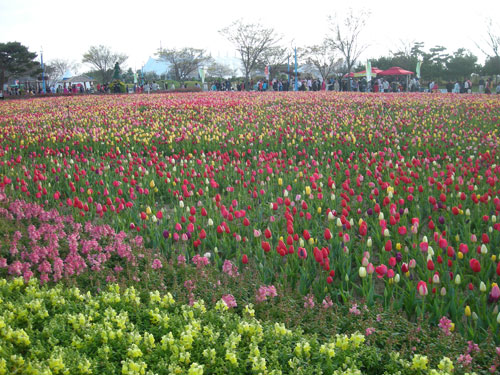
Devastated by Korea's largest oil spill in December 2007, the island of Anmyeondo in South Chungcheong Province is trying to restore the local economy by developing Korea's domestic floricultural industry. Case in point is its Korea Floritopia 2009 festival. Millions of flowers are on display at this special event.
Read the post on the DiscoveringKorea.com blog.
Más sobre Korea Floritopia 2009
53: Pyeongchang Trout Festival
At this famous winter festival, visitors break the ice and try their luck at trout fishing. Visitors can also try traditional Korean winter folk games such as snow sledding, kite flying, and more.
Más sobre Pyeongchang Trout Festival
54: Wolmido Island (???)
Wolmido Island is actually a small peninsula off the city of Incheon known for its waterfront boardwalk, amusement park and a row of cute and colorful raw fish restaurants.
Más sobre Wolmido Island (???)
55: Freedom Park (????)
Jayu or Freedom Park in the city of Incheon celebrates General Douglas MacArthur's dramatic victory at the Battle of Incheon during the Korean War, and features a statue of the general, gardens, and a towering sculpture celebrating 100 years of Korea and U.S. relations. There's also a panoramic view of the busy Incheon port.
Más sobre Freedom Park (????)
56: Incheon's Chinatown
Incheon's Chinatown is Korea's oldest. Famous as the birthplace of the popular noodle dish, jjajangmyeon, the neighborhood features three traditional gates donated by Incheon's Chinese sister city, Weihai.
Más sobre Incheon's Chinatown
57: Songdo (??)
Built on reclaimed land in Incheon Harbor, Songdo is being built from scratch with a reported $40-billion price tag, making it the largest private development project undertaken at any time, anywhere. In addition to many cultural, educational and leisure venues, a 610-meter high tower expects to be the world's third tallest upon completion in 2012.
Más sobre Songdo (??)
58: Deoksugung Palace (???)
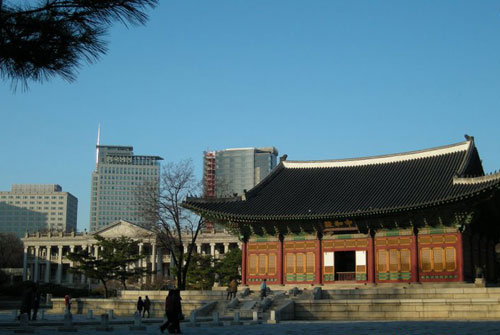
Más sobre Deoksugung Palace (???)
59: Songsan-ri Burial Tombs (??????/????)
The Songsan-ri Burial Tombs in South Chuncheong Province (near the city of Gongju) features tombs of Baekje Kingdom monarchs, including King Muryeong. Several National Treasures unearthed from the tomb are on view at the adjacent museum and in a recreated tomb at the site.
Más sobre Songsan-ri Burial Tombs (??????/????)
60: Jungnangcheon (???)
The Jungnangcheon is a stream running through Seoul's northeastern neighborhoods before it connects with the Cheonggye Stream and empties into the Han River.
Más sobre Jungnangcheon (???)
61: Wolchulsan Mountain National Park (???????)

Wolchulsan Mountain National Park is South Korea's smallest. Although just 41 square kilometers, the park's dramatic rise from the flat farmlands of Gangjin and Yeongam Counties creates beautiful vistas.
Read the post on the DiscoveringKorea.com blog.
Más sobre Wolchulsan Mountain National Park (???????)
62: Hakindang (???)
The Hakindang is a graceful upper class home from the Joseon era that has been converted for visitors' use.
Más sobre Hakindang (???)
63: Boseong's Daehan Green Tea Plantation (????)
Read the post on the DiscoveringKorea.com blog.
Más sobre Boseong's Daehan Green Tea Plantation (????)
64: Sinsa-dong Garosugil (??? ????)
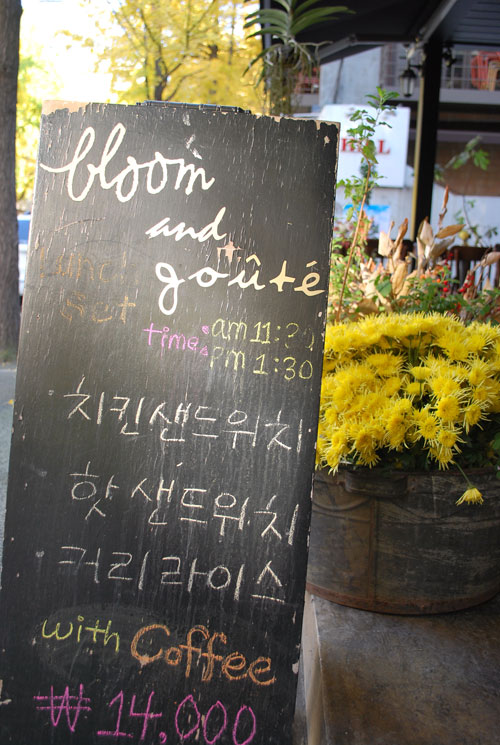
Más sobre Sinsa-dong Garosugil (??? ????)
65: Pungnammun Gate (???)
The stately Pungnammun Gate is the only remaining gate of Jeonju's city fortress. Rebuilt in 1768, its architecture is similar to other great gates, except that its pillarrs extend from the first level up into the second.
Más sobre Pungnammun Gate (???)
66: Yangnyeongsi Market (????)
Since 1658, Daegu's Yangnyeongsi Market has been a destination in northeast Asia for those seeking ginseng, reindeer horns and lizard tails. Hundreds of medicinal shops still offer traditional remedies to life's aches and pains. each spring the market hosts an annual festival.
Más sobre Yangnyeongsi Market (????)
67: Jeonju Hanok Village (??????)
One of Korea's best examples of a hanok, or Korean traditional village is in the city of Jeonju, located in North Jeolla Province. Jeonju was once the capital of Korea's Baekje Dynasty, and also the home of the Joseon Dynasty's founding king, Yi Seong-gye.
Más sobre Jeonju Hanok Village (??????)
68: Gyodong Dawon Traditional Tea House
Read the post on the DiscoveringKorea.com blog.
Más sobre Gyodong Dawon Traditional Tea House
69: Boseong Yulpo Spa (?????????)
The Yulpo Haesu Nogchatang is a spa that pumps seawater from 120 meters below ground and mixes it with green tea.
Más sobre Boseong Yulpo Spa (?????????)
72: Korean Broadcasting System (KBS) (????)
The main campus of KBS, the Korean Broadcasting System. KBS is among South Korea's most influential media organizations. It's also where Discovering Korea is produced^^
Más sobre Korean Broadcasting System (KBS) (????)
73: Bucella (????????)
Read the post on the DiscoveringKorea.com blog.
Más sobre Bucella (????????)
74: Cork for Turtle, Mug for Rabbit
The first floor and sunken B1 is a spare but cozy café, while the upstairs is an intimate restaurant encouraging wine consumption.
Más sobre Cork for Turtle, Mug for Rabbit
75: Crazy Horse (??????)
This American Indian-themed, live music bar in Sinsa-dong's Garosugil neighborhood has an entrance so narrow you have to shimmy sideways to get in. A comfortable and unpretentious setting.
Más sobre Crazy Horse (??????)
76: Gallery Yeh (???)
Gallery Yeh in Sinsa-dong's Garosugil neighborhood features several exhibitions per year focused on fine art, sculpture, printing and original installations by contemporary Korean and foreign artists.
Más sobre Gallery Yeh (???)
77: Andong Hahoe Village (?? ????)
Hahoe Village, near the city of Andong, is nestled in one of the curves of the Nakdong River in North Gyeongsang Province. The area is a well-preserved example of a typical clan village from the Joseon Dynasty.
Más sobre Andong Hahoe Village (?? ????)
78: Yangjindang (???)
Yangjindang, in North Gyeongsang Province's Hahoe Village, is the head house of the Ryu clan. It's currently the home of the clan's 14th direct descendant.
Más sobre Yangjindang (???)
79: Chunghyodang Manor (???)
In the south section of Hahoe Village is Chunghyodang Manor, which is designated Treasure #414. The stately building is home to descendants of Ryu Song-nyong, a 16th century scholar and prime minister.
Más sobre Chunghyodang Manor (???)
80: Hahoe Mask Museum (???????)
The Hahoe Mask Museum features hundreds of masks from Korea and around the world. The nearby city of Andong hosts a popular annual mask festival.
Más sobre Hahoe Mask Museum (???????)
81: Gwangju Biennale (??????)
Más sobre Gwangju Biennale (??????)
82: Daein Market (????)
Más sobre Daein Market (????)
83: Uijae Museum of Korean Art (?????)
Más sobre Uijae Museum of Korean Art (?????)
84: Noryangjin Fish Market (???????)
Seoul's Noryangjin Fish Market features some 700 stalls selling stingrays, halibut and pickled clams (among many other sea creatures).
Más sobre Noryangjin Fish Market (???????)
85: Mt. Ansan (??)
Read the post on the DiscoveringKorea.com blog.
Más sobre Mt. Ansan (??)
88: Seonyudo Island (???)
Read the post on the DiscoveringKorea.com blog.
Más sobre Seonyudo Island (???)
89: Hangang River Park - Mangwon Area (???? - ??)
Más sobre Hangang River Park - Mangwon Area (???? - ??)
90: Seoul Station (???)
Más sobre Seoul Station (???)
91: Gyeonghuigung Palace (???)
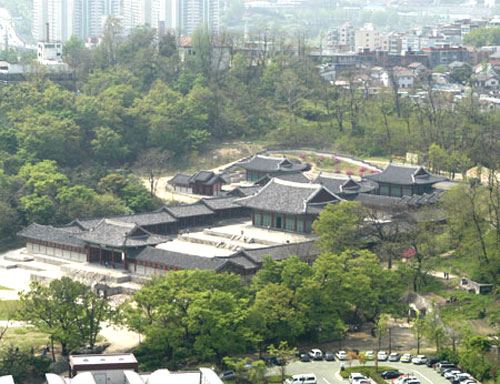
Más sobre Gyeonghuigung Palace (???)
93: Doseonsa Temple (???)
Doseonsa Temple is located on the slopes of Bukhansan Mountain on the border of Seoul and Gyeonggi Province. Buuilt during the second year of the reign of Silla's King Gyeongmun, faithful come here to pray for the nation's defense. A 30-foot tall image of the Avalokitesvara Bodhisattva is carved on a cliff.
Más sobre Doseonsa Temple (???)
94: Mt. Dobongsan (???)
Watch the video on the DiscoveringKorea.com blog.
Más sobre Mt. Dobongsan (???)
95: Bukhansan-Insubong (???)
Read the post on the DiscoveringKorea.com blog.
Más sobre Bukhansan-Insubong (???)
96: Gahoe-dong Neighborhood (???)
The neighborhood of Gahoe-dong in Seoul's Bukchon area is one of the best (and last) places to see scores of hanok, or traditional style Korean homes. Although the hanok style is commonly associated with the Joseon Dynasty, most of the homes in Bukchon date to the 1920s or later. Still, it's one of the best places in Seoul to see a slice of old Seoul.
Más sobre Gahoe-dong Neighborhood (???)
97: Samcheong-dong (???)
Located near Seoul's Gyeongbokgung Palace and the Bukchon neighborhood isthe very trendy Samcheong-dong, a great mix of galleries, cafés and restaurants.
Más sobre Samcheong-dong (???)
99: Seoul Museum of Chicken Art (??????)
Located in the historic Seoul neighborhood of Bukchon, this curious art museum offers art of chickens, not by them, but nevertheless can boast a nice collection.
Más sobre Seoul Museum of Chicken Art (??????)
100: Hansangsu Embroidery Museum (????????)
The Hansangsu Embroidery Museum is located in Seoul's historic Bukchon neighborhood.
Más sobre Hansangsu Embroidery Museum (????????)
101: Museum of Korean Buddhist Art (?????????)
The Museum of Korean Buddhist Art is located in the historic Seoul neighborhood of Bukchon.
Más sobre Museum of Korean Buddhist Art (?????????)
102: Jamsil Olympic Stadium (???????)
The site of the 1988 Olympic Summer Games opening and closing ceremonies, the Jamsil Olympic Stadium continues to host events, including the 2008 Design Olympiad.
Más sobre Jamsil Olympic Stadium (???????)
103: Mt. Seoraksan (???)
Mt. Seoraksan is undeniably South Korea's most famous peak.
Más sobre Mt. Seoraksan (???)
104: Mt Jirisan (???)
Read the post on the DiscoveringKorea.com blog.
Más sobre Mt Jirisan (???)
105: Mt. Naejangsan (???)
Mt. Naejangsan is on the border of North and South Jeolla provinces. The park is especially famous during the autumn, when a 200-meter stretch becomes a tunnel of yellow, orange and crimson leaves. Other attractions include Baegyangsa Temple and nearby traditional folk villages.
Más sobre Mt. Naejangsan (???)
106: Heyri Artists Village (??? ????)
About one hour north of Seoul is a picturesque spot where the Han and Imjin rivers meet. It's also where over 500 painters, musicians, photographers, writers and sculptors live and work together in a cultural art village near the city of Paju in Gyeonggi Province.
Más sobre Heyri Artists Village (??? ????)
107: Geumsansa Temple (???)
Geumsansa Temple is located on the slopes of Moaksan Mountain. Founded over 1,400 years ago, the temple is best known for its Maitreya Hall, which is Korea's only remaining three-story, pre-modern building.
Más sobre Geumsansa Temple (???)
108: Naksansa Temple (???)
Located on a bluff overlooking the East Sea, Naksansa Temple was once of the country's most beautiful Buddhist temples until a 2005 fire destroyed most of the wooden structures and a 15th century bronze bell. However, restoration is underway and the temple's pavilion remains a tranquil spot to watch the sunrise.
Más sobre Naksansa Temple (???)
109: Sokcho Beach (??????)
Read the post on the DiscoveringKorea.com blog.
Más sobre Sokcho Beach (??????)
110: Illhyun Museum's "Sky's the Limit" Observatory
This striking and modern, 7-story high steel edifice was designed by French artist Didier Fiuza Faustino, and offers panoramic views of Dongho Beach.
Más sobre Illhyun Museum's "Sky's the Limit" Observatory
111: Ilhyun Museum
This peculiar museum was practically empty of staff or visitors when we stopped by, but the "Sky's the Limit" observatory located on its grounds is definitely worth a look.
Más sobre Ilhyun Museum
112: Gyeongpo Beach (???????)
Gangneung's Gyeongpo Beach is popular with youngsters. A buffer of windswept pine trees and a boardwalk separate the busy street from the equally busy soft sand beach. While folks ate ice cream, others were pulled on inflatable sea biscuits or bungee jumped.
Más sobre Gyeongpo Beach (???????)
113: Shinheungsa Temple (???)
Shinheungsa Temple is located on Seoraksan Mountain and features colorful buildings and a large statue of the Buddha (obviously).
Más sobre Shinheungsa Temple (???)
114: House of Sharing (????)
The House of Sharing was built in 1995 to provide a home for some of the elderly women who were subjected to sexual slavery by the Japanese military during World War II. The site also includes the Museum of Sexual Slavery by the Japanese Military.
Más sobre House of Sharing (????)
115: Jongmyo Royal Shrine (??)
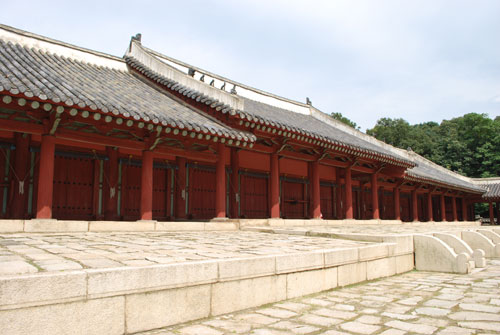
Más sobre Jongmyo Royal Shrine (??)
116: Seongyojang (?????)
Located in the Gangwon Province city of Gangneung is Seongyojang. Built in 1703 by an 11th-generation descendant of a Korean prince, the home is perhaps the best example of a typical yangban, or artistocrat's home from the Joseon era.
Más sobre Seongyojang (?????)
117: Ojukheon (???)
Gangneung's beautiful Ojukheon is a home that was passed down through the family of Lady Shin Saimdang and Yul Gok for over 500 years.
Más sobre Ojukheon (???)
118: Gyeongpodae Pavilion (???)
The Gyeongpodae Pavilion overlooks the Gangneung Lagoon. Among the building's 28 pillars is a poem by the philosopher-statesman, Yul Gok.
Más sobre Gyeongpodae Pavilion (???)
119: Seoul Museum of History
Read the post on the DiscoveringKorea.com blog.
Más sobre Seoul Museum of History
120: Sunrise Peak (?????)
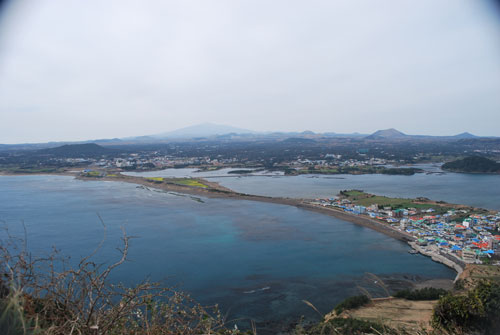
This archetypal tuff cone was formed by hydrovolcanic eruptions about 5,000 years ago. Today, the 182-meter cone forms a conspicuous peninsula on Jeju Island's eastern coast. The volcanic cone is 600 meters wide and 990 meters tall. Its crater is lined with 99 spires that resemble a crown or castle walls.
Read the post on the DiscoveringKorea.com blog.
Más sobre Sunrise Peak (?????)
121: The Prada Transformer

On the grounds of Gyeonghuigung Palace in central Seoul is the Prada Transformer, a collaboration of the Italian designer and Dutch architect Rem Koolhaas. Through 2009, the 20-meter high, 180-ton structure will host a variety of fashion, art, film and architecture exhibitions.
Más sobre The Prada Transformer
122: Ddangkkeut Village (??)

Ddangkkeut Village is located on the Korean Peninsula's southern-most point. The small hamlet shuttles ferries to nearby islands and is a short walk away from the Mt. Dalmasan observatory, which affords sweeping views of Korea's namhae or southern coast.
Read the post on the DiscoveringKorea.com blog.
Más sobre Ddangkkeut Village (??)
123: Bogildo Island (???)
Read the post on the DiscoveringKorea.com blog.
Más sobre Bogildo Island (???)
124: Gyeongbokgung Palace (???)
Watch the video here.
Más sobre Gyeongbokgung Palace (???)
125: Han River Cruise Pier (Yeouido)
Más sobre Han River Cruise Pier (Yeouido)
126: Han River Cruise Pier (Jamdubong)
Más sobre Han River Cruise Pier (Jamdubong)
127: Han River Cruise Pier (Sangam)
Más sobre Han River Cruise Pier (Sangam)
128: Han River Cruise Pier (Tteukseom)
Más sobre Han River Cruise Pier (Tteukseom)
129: Han River Cruise Pier (Jamsil)
Más sobre Han River Cruise Pier (Jamsil)
130: Han River Cruise Pier (Yanghwa)
Más sobre Han River Cruise Pier (Yanghwa)
131: Nagwon-dong (???)
For several decades, Seoul's Nagwon-dong neighborhood has been filed with scores of tiny bars catering to gay men. In the warmer months, the open-air food stalls near the Jongno-3ga subway exits are another popular gay venue.
Más sobre Nagwon-dong (???)
132: Tapgol Park (????)
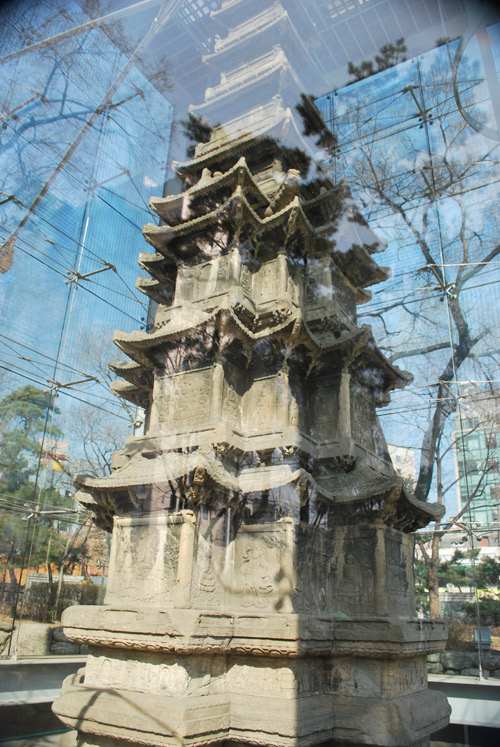
This historic park was the site of the beginning of Korea's March 1st Movement, a nationwide series of strikes and protests against Japanese colonial rule. Today, the park is popular among older men and is also the site of a 10 tier Wongaksa pagoda (???????).
Más sobre Tapgol Park (????)
133: N Seoul Tower on Mt. Namsan
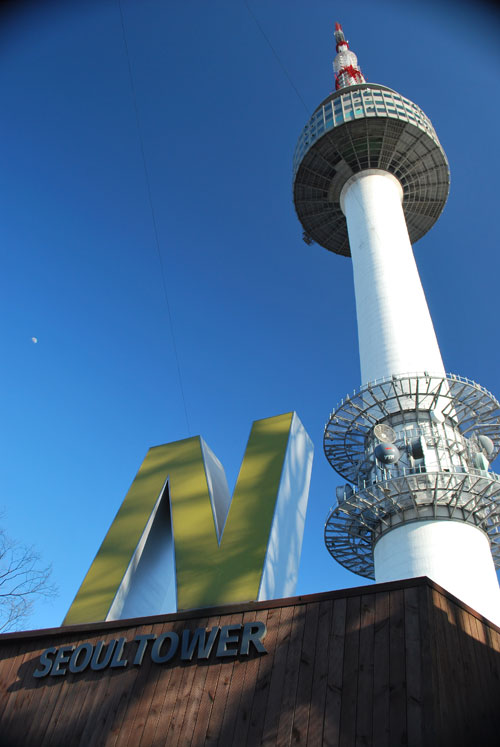
Built in 1969, N Seoul Tower is a 237-meter-high communication tower located atop Mt. Namsan in central seoul. Topping out at about a half-kilometer above sea level, the tower's observation decks offer superb 360-degree views of Seoul.
Más sobre N Seoul Tower on Mt. Namsan
134: Namsangol Hanok Village (???????)
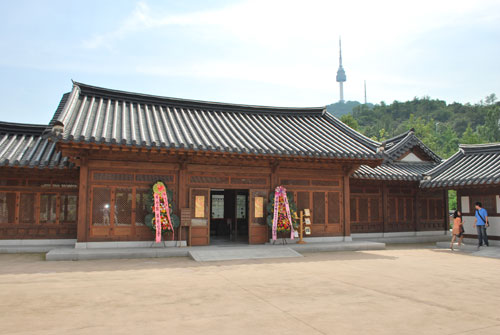
At Namsan Park's northeast side is the Namsangol Hanok Village (???????). Built to resemble a Korean folk village, free traditional wedding ceremonies and cultural performances can be enjoyed there in the summer and fall.
Read the post on the DiscoveringKorea.com blog.
Más sobre Namsangol Hanok Village (???????)
135: Namsan Cable Car
South Korea's first cable car whisks people from the outskirts of the Myeongdong retail district to the top of Nam Mountain, site of N Seoul Tower.
Más sobre Namsan Cable Car
136: Gangnamdae-ro Media Poles
 As part of Seoul City's "Design Streets" project, a 760-meter stretch of street from Gangnam Station to Kyobo Tower has been fitted with dozens of tall media poles that emit colorful light shows, can take your photo and even email it to you.
As part of Seoul City's "Design Streets" project, a 760-meter stretch of street from Gangnam Station to Kyobo Tower has been fitted with dozens of tall media poles that emit colorful light shows, can take your photo and even email it to you.Read the post on the DiscoveringKorea.com blog.
Más sobre Gangnamdae-ro Media Poles
137: Banpo Bridge (????)

Más sobre Banpo Bridge (????)
138: Kyobo Tower Bookstore (????)
This big book store in the basement of the Kyobo Tower is a favorite place to peruse books and a diverse array of office products, stationery, notebooks, supplies, and even great gifts. The store includes a sizeable English-language section as well.
Más sobre Kyobo Tower Bookstore (????)
139: Gangnam Station (???)
Seoul's metro (subway) system is very well used, and Gangnam Station is its busiest. If you want to experience feeling like you're part of a human ant hill, just head to exit #7 on a Friday or Saturday evening (or any evening, really). Once you emerge, enjoy the lights and signs while dodging well-dressed two- three- and nine-somes.
Más sobre Gangnam Station (???)
140: Dosan Park (????)
This attractive park in fancy Apgujeong is in honor of Dosan Ahn Chang-ho, a Korean independence icon that's regarded by many as the father of Korean Americans.
Más sobre Dosan Park (????)
141: Berlin Plaza (?????)
Berlin Plaza is a corner of concrete adjacent to the Cheonggye Stream that hosts a small piece of the Berlin Wall. Both Korea and Germany were nations divided by the Cold War. For the past few years, it's also been the starting point for Seoul's Korea Queer Culture Festival (KQCF) parade.
Más sobre Berlin Plaza (?????)
142: Korea Queer Culture Festival 2009 Parade Route

Más sobre Korea Queer Culture Festival 2009 Parade Route
143: Seoul Art Cinema
The Seoul Art Cinema is located on the top floor of the Nagwon Arcade. The Cinema features art house films and was the site of the 2009 Seoul LGBT Film Festival (SeLFF).
Más sobre Seoul Art Cinema
144: Pulse Dance Bar
Pulse is currently Seoul's most popular gay dance venue for electronic music.
Más sobre Pulse Dance Bar
145: "Homo Hill"
This short stretch of narrow street in Itaewon is affectionately called "Homo Hill" for its half-dozen bars and clubs catering primarily (but not exclusively) to gay men. Unlike Seoul's other gay areas, Homo Hill features a mix of Koreans and foreigners.
Más sobre "Homo Hill"
146: Hamilton Hotel
The Hamilton Hotel is an icon in Seoul's Itaewon neighborhood. It's rooftop swimming pool is a particular favorite among foreigners and the small (but growing!) number of sunbathing Koreans. Given its proximity to "Homo Hill", oiled up dudes stretched poolside in pink thongs aren't unheard of.
Más sobre Hamilton Hotel
147: Saenamteo Martyr's Shrine
The attractive Saenamteo Martyr's Shrine, built in a "traditional" style, is wedged beside train tracks an apartments in the busy Ichon neighborhood of Seoul. This area near the Han River was the site of some of the mass executions of Catholics in Korea's early attempts to extinguish Christianity.
Más sobre Saenamteo Martyr's Shrine
148: Yongsan Station (???)
Yongsan Station, which is connected to subway lines 1 and the Jungang subway line, is the departure point for several KTX "Honam" routes, which are mostly destinations in the Southwest Jeolla region. KTX trains heading to Gyeongsang Province cities like Daegu and Busan leave from Seoul Station.
Más sobre Yongsan Station (???)
149: Pimatgol (???)
Read the post about Pimatgol on the DiscoveringKorea.com blog.
Más sobre Pimatgol (???)
150: Pimatgol (???)
Read the post about Pimatgol on the DiscoveringKorea.com blog.
Más sobre Pimatgol (???)
151: West Pimatgol (????)
Read the post about Pimatgol on the DiscoveringKorea.com blog.
Más sobre West Pimatgol (????)
152: Pimatgol (???)
Read the post about Pimatgol on the DiscoveringKorea.com blog.
Más sobre Pimatgol (???)
153: Pimatgol (???)
Read the post about Pimatgol on the DiscoveringKorea.com blog.
Más sobre Pimatgol (???)
154: East Pimatgol (????)
Read the post about Pimatgol on the DiscoveringKorea.com blog.
Más sobre East Pimatgol (????)
155: Pimatgol (???) (Recently Demolished)
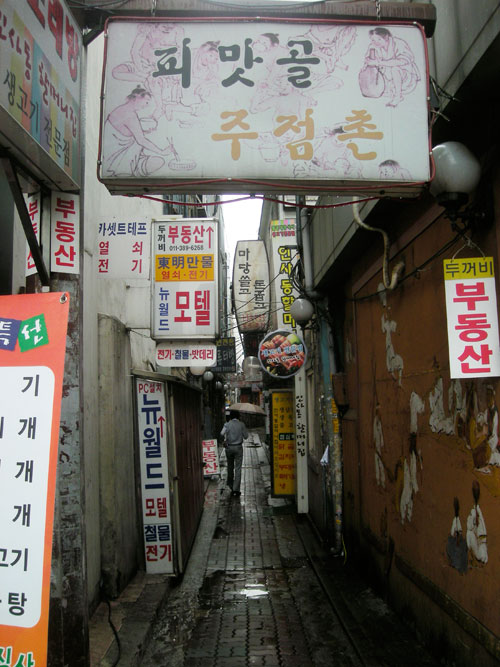
Pimtagol is a narrow alley located alongside both sides of Jongno, a major Seoul thoroughfare for 600 years. The alley was created so the city's working people could avoid walking along Jongno, where they would be forced to stop and prostrate themselves when aristocrats and dignitaries passed. To meet their needs, hundreds of bars and eateries were established along Pimatgol's path. Unfortunately, this part of the historic alley was demolished in May 2009.
Read the post about Pimatgol on the DiscoveringKorea.com blog.
Más sobre Pimatgol (???) (Recently Demolished)
156: Pimatgol (???) (Recently Demolished)
Read the post about Pimatgol on the DiscoveringKorea.com blog.
Más sobre Pimatgol (???) (Recently Demolished)
157: Sungnyemun (???)
Sungnyemun, better known as Namdaemun (Great South Gate) was one of four main gates that allowed access into the fortress city built by King Taejo in 1392. Tragically, the gate was destroyed by an arsonist in 2007 and is currently undergoing restoration.
Más sobre Sungnyemun (???)
158: Heunginjimun (????)
Heunginjimun, better known as Dongdaemun (Great East Gate) is one of only two surviving main gates from the fortress city built by King Taejo in 1392.
Más sobre Heunginjimun (????)
159: Boshingak Bell Pavilion
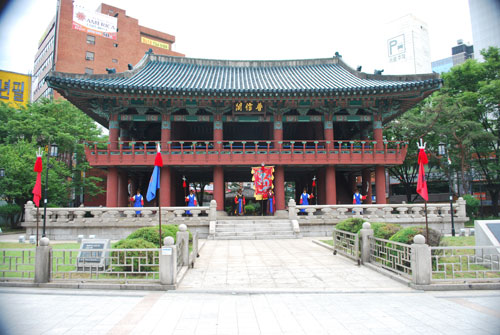
Boshingak (???) is a large bell pavilion located at the Jonggak Intersection of Jongno, a major thoroughfare in central Seoul that bears its name ("Jongno" literally means Bell Street). Originally constructed in 1396 and moved to its current location in 1440, the bell was rung to announce the time and to signal the opening and closing of the city's fortress gates or in the event of fire. The structure has been destroyed several times by war and fire.
A bell-ringing ceremony occurs daily (except Mondays) year-round from 11:30-12:30.
Más sobre Boshingak Bell Pavilion
160: Express Bus Terminal
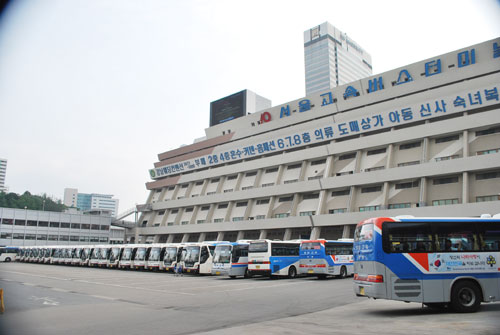
The terminal is also famous for the huge underground shopping mall located... well, underneath the terminal.
Read the post and watch the video on the DiscoveringKorea.com blog.
Más sobre Express Bus Terminal
161: Gangnam Underground Shopping Arcade (??????)
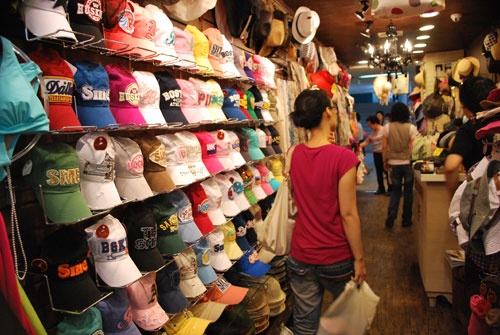
Más sobre Gangnam Underground Shopping Arcade (??????)
162: Han River Park - Banpo (???? - ??)

Más sobre Han River Park - Banpo (???? - ??)
163: Gongneung Burial Tomb (??)
Read the post on the DiscoveringKorea.com blog.
Más sobre Gongneung Burial Tomb (??)
164: Taereung Royal Tomb (??)
One of 40 royal tombs from ancient Korea's Joseon Dynasty, which was just inscribed to the UNESCO World Heritage List.
Read the post on theDiscoveringKorea.com blog.
Más sobre Taereung Royal Tomb (??)
166: Heolleung Royal Tomb (??)
One of 40 royal tombs from ancient Korea's Joseon Dynasty, which was just inscribed to the UNESCO World Heritage List.
Read the post on theDiscoveringKorea.com blog.
Más sobre Heolleung Royal Tomb (??)
167: Jeongneung Royal Tomb (??)

One of 40 royal tombs from ancient Korea's Joseon Dynasty, which was just inscribed to the UNESCO World Heritage List.
Read the entire post on the DiscoveringKorea.com blog.
Más sobre Jeongneung Royal Tomb (??)
168: Seolleung Royal Tomb (??)
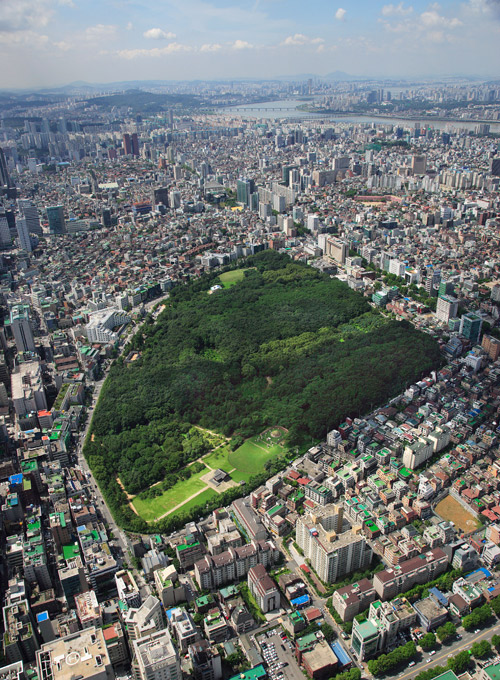
One of 40 royal tombs from ancient Korea's Joseon Dynasty, which was just inscribed to the UNESCO World Heritage List.<br><br>Read the post on the<a href="http://discoveringkorea.com">DiscoveringKorea.com</a> blog.
Más sobre Seolleung Royal Tomb (??)
169: Seonjeongneung (???)
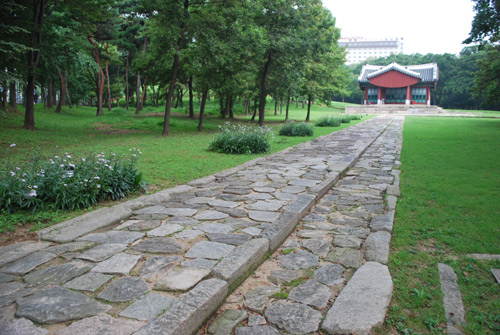
One of 40 royal tombs from ancient Korea's Joseon Dynasty, which was just inscribed to the UNESCO World Heritage List.
Read the post on the DiscoveringKorea.com blog.
Más sobre Seonjeongneung (???)
171: Yeonghwaewon (???)
One of 40 royal tombs from ancient Korea's Joseon Dynasty, which was just inscribed to the UNESCO World Heritage List.<br><br>Read the post on the<a href="http://discoveringkorea.com">DiscoveringKorea.com</a> blog.
Más sobre Yeonghwaewon (???)
173: Uireung Royal Tomb (??)
One of 40 royal tombs from ancient Korea's Joseon Dynasty, which was just inscribed to the UNESCO World Heritage List.
Read the post on theDiscoveringKorea.com blog.
Más sobre Uireung Royal Tomb (??)
175: Independence Hall of Korea (?????)
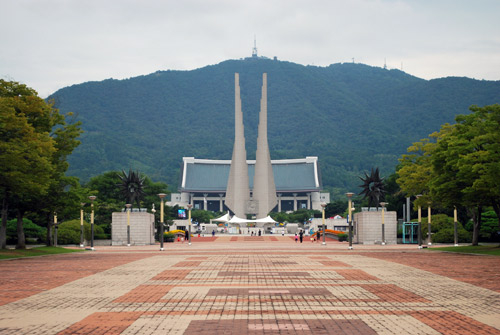
The extensive complex was opened to the public in 1982, and serves to collect, preserve and display a wealth of data about the Korean civilization, with a special focus on the nation's early 20th century independence movement against Japan.
Read the full post on the DiscoveringKorea.com blog.
Más sobre Independence Hall of Korea (?????)
176: Gwanghwamun Plaza (?????)

Seoul's newest landmark is a public plaza that extends some 19,000 square meters in the middle of busy Sejong Boulevard. Located in front of Gyeongbok Palace's main Gwanghwamun Gate, the plaza features a "flower carpet" of 120,000 flowers, a water fountain, and an underground gallery called the Haechi Madang.
Read the post on the DiscoveringKorea.com blog.
Más sobre Gwanghwamun Plaza (?????)
177: Statue of Admiral Yi Sun-shin (???)
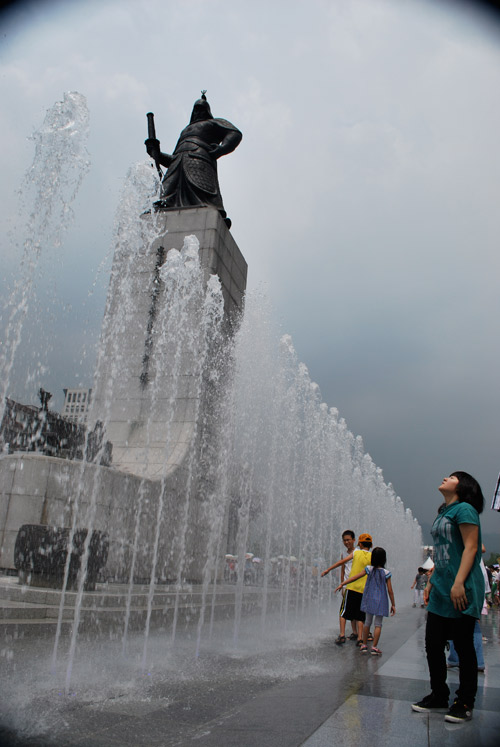
At the entrance to Sejong Boulevard in downtown Seoul is a statue of Admiral Yi Sun-shin (???), Korea's greatest naval hero. The recent renovation of Gwanghwamun Plaza has surrounded the statue with dozens of water fountains, some reaching 20 meters into the air.
Read the post on the DiscoveringKorea.com blog.
Más sobre Statue of Admiral Yi Sun-shin (???)
178: Jeonghyeonwanghureung (?????)
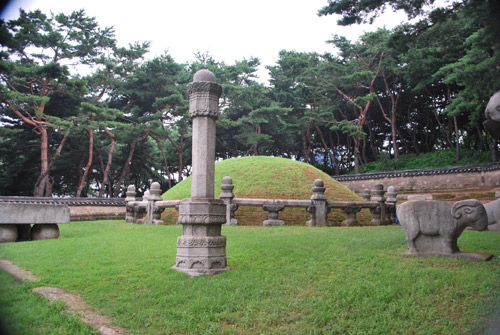
Jeonghyeonwanghureung (?????) is the tomb of Queen Jeongbyeon, the second queen of King Seongjong, the 9th monarch of the Joseon Dynasty.
One of 40 royal tombs from ancient Korea's Joseon Dynasty, which was just inscribed to the UNESCO World Heritage List.
Read the entire post on the DiscoveringKorea.com blog.
Más sobre Jeonghyeonwanghureung (?????)
179: Jaesil at the Samneung Royal Tombs
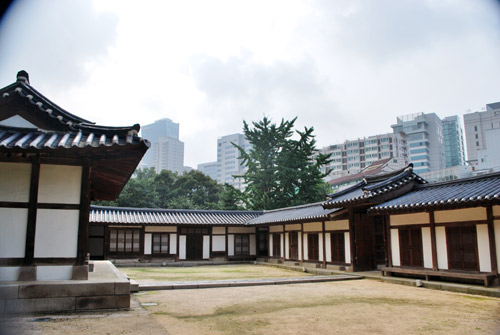
Jaesil (??) is a traditional house used by priests to prepare the sacrificial rites for the deceased kings.
Read the entire post on the DiscoveringKorea.com blog.
Más sobre Jaesil at the Samneung Royal Tombs
180: View from the Seogang Bridge (????)
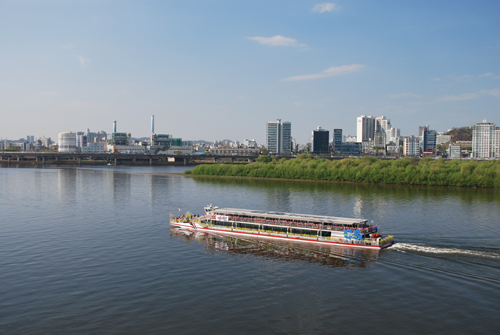
The view of a Hangang River Ferry from the Seogang Bridge. The bird sanctuary Bamseom Islet is in the background.
Más sobre View from the Seogang Bridge (????)
181: Grandmother & Grandfather Rocks
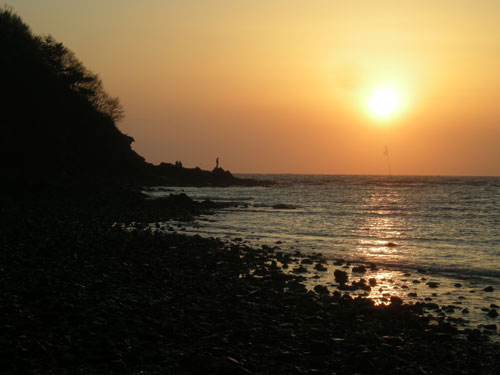
The Grandmother & Grandfather Rocks off Anmyeondo Island's Kkotji Beach are famous for beautiful sunsets.
Read the entire post on the DiscoveringKorea.com blog.
Más sobre Grandmother & Grandfather Rocks
182: Yeongdo Island (??)

Yeongdo Island as seen from Busan Tower, in Yongdusan Park, Busan.
Read the entire post at the DiscoveringKorea.com blog.
Más sobre Yeongdo Island (??)
184: Sindang-dong Tteokbokki Street

Más sobre Sindang-dong Tteokbokki Street
185: Dumulmeori (????)

Read the post on the DiscoveringKorea.com blog.
Más sobre Dumulmeori (????)
186: Semiwon (???)

Más sobre Semiwon (???)
189: Sunrise 2010

Más sobre Sunrise 2010
190: Coffeest (Café)

Más sobre Coffeest (Café)
191: Cabae Duream (café)

Watch the video here.
Más sobre Cabae Duream (café)
192: Boramae Park (?????)
Read the post and watch the video on DiscoveringKorea.com.
Más sobre Boramae Park (?????)
193: Yeonjudae Hermitage (???)

Más sobre Yeonjudae Hermitage (???)
194: Mt. Gwanaksan (???)

Más sobre Mt. Gwanaksan (???)
195: Haneul Park (????)
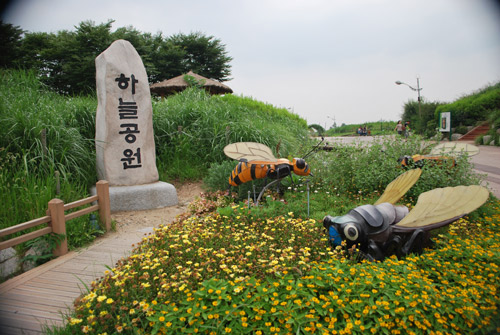
Más sobre Haneul Park (????)
197: Cheonchuksa Temple (???)
| From Mt. Dobongsan (???) |
Watch the video on the DiscoveringKorea.com blog.
Más sobre Cheonchuksa Temple (???)
198: Neungwonsa Temple (???)
| From Mt. Dobongsan (???) |
Watch the video and read the post on the DiscoveringKorea.com blog.
Más sobre Neungwonsa Temple (???)
199: Jongno Bindaeddeok (?? ???)
Más sobre Jongno Bindaeddeok (?? ???)
200: MTL Modern Bar
Más sobre MTL Modern Bar
201: Mirinae Restaurant (???)
02-735-9871
Más sobre Mirinae Restaurant (???)
202: Taj: Taste of India
http://taj.co.kr
Más sobre Taj: Taste of India
203: Hakgojae Gallery (???)
Más sobre Hakgojae Gallery (???)
204: Book Café Naeseojae (??? ???)
Más sobre Book Café Naeseojae (??? ???)
205: Gapsan Myeonok (????)
Más sobre Gapsan Myeonok (????)
206: Saetgang Ecological Park (??????)
 |
| From Yeouido Island (???) |
Read the full post on DiscoveringKorea.com.
Más sobre Saetgang Ecological Park (??????)
207: Chango 43 (Restaurant)
Read the article on DiscoveringKorea.com.
Más sobre Chango 43 (Restaurant)
208: Jinju Jip (???) (Restaurant)
Más sobre Jinju Jip (???) (Restaurant)
209: Ola! (Restaurant)
Read the article on DiscoveringKorea.com.
Más sobre Ola! (Restaurant)
210: Paul (restaurant)
| From Seoul's Best Brunch |
Read the post on DiscoveringKorea.com
Más sobre Paul (restaurant)
211: Naru Café
Read the post at DiscoveringKorea.com.
Más sobre Naru Café
212: Hyundai Department Store's U-Plex Mall
 |
| From Sinchon & Edae (?? / ??) |
Watch the video here.
Read the entire post on DiscoveringKorea.com.
Más sobre Hyundai Department Store's U-Plex Mall
213: Sodojeok (???) (Restaurant)
Watch the video here.
Read the entire post on DiscoveringKorea.com.
Más sobre Sodojeok (???) (Restaurant)
214: Egg & Spoon Race
Watch the video here.
Read the entire post on DiscoveringKorea.com.
Más sobre Egg & Spoon Race
215: Sinchon Walking Street
This vibrant stretch of road in west Seoul's Sinchon neighborhood is lined with restaurants, cafés and noraebang singing rooms. During the spring, the street is lined with flowering cherry trees.
Más sobre Sinchon Walking Street
216: Sinchon Train Station (Gyeonghui Line)
This large train station is on Seoul Metro's Gyeonghui Line and is one stop from Seoul Station. The trains run infrequently (about one per hour and two during rush hour), but offer a quick (6 minutes) ride to Seoul Station.
Más sobre Sinchon Train Station (Gyeonghui Line)
217: Vicolo Caffetteria (???)
Más sobre Vicolo Caffetteria (???)
218: Yonsei University (?????)
| From Sinchon & Edae (?? / ??) |
Watch the video here.
Read the post on DiscoveringKorea.com.
Más sobre Yonsei University (?????)
219: Oedo Island (??)
| From Oedo Island (??) |
Read the post on DiscoveringKorea.com.
Más sobre Oedo Island (??)
220: Geojedo Haegeumgang (?? ???)
| From Oedo Island (??) |
Read the post on DiscoveringKorea.com.
Más sobre Geojedo Haegeumgang (?? ???)
223: Haewon Restaurant (????)
| From Oedo Island (??) |
Más sobre Haewon Restaurant (????)
224: Busan Station (train) (???)
Más sobre Busan Station (train) (???)
225: Panorama Lounge at the Westin Chosun
 |
| From Busan (??) |
Más sobre Panorama Lounge at the Westin Chosun
226: Jongno Bindaetteok (?????)
Más sobre Jongno Bindaetteok (?????)
227: Yeolchajip or Train House (???)
Read the post on DiscoveringKorea.com.
Más sobre Yeolchajip or Train House (???)
228: The Lock Museum (?????)
| From Seoul's Lock Museum (?????) |
Watch the video here.
Read the post on DiscoveringKorea.com.
Más sobre The Lock Museum (?????)
229: Changuimun Gate (???)
| From Buam-dong (???) |
Watch the video about Buam-dong.
Read the post on DiscoveringKorea.com.
Más sobre Changuimun Gate (???)
230: Whanki Museum (?????)
Read the post on DiscoveringKorea.com.
Más sobre Whanki Museum (?????)
231: Cheers! (restaurant)
| From Buam-dong (???) |
Read the post on DiscoveringKorea.com.
Más sobre Cheers! (restaurant)
232: Art for Life (??????) (restaurant)
| From Buam-dong (???) |
Read the post on DiscoveringKorea.com.
Más sobre Art for Life (??????) (restaurant)
233: Ivy Café (????)
 |
| From Buam-dong (???) |
Read the post on DiscoveringKorea.com.
Más sobre Ivy Café (????)
235: Saseongam Hermitage (???)
| From Saseongam Hermitage (???) |
Read the full post on DiscoveringKorea.com.
Más sobre Saseongam Hermitage (???)
241: Jin's "Around the Block" Journey, Day 1
Más sobre Jin's "Around the Block" Journey, Day 1
243: Sanuki (???)
Más sobre Sanuki (???)
244: Dongmun Udong House (???????)
Más sobre Dongmun Udong House (???????)
245: Yubuchobap (????)
Más sobre Yubuchobap (????)
247: Ajigen (???)
Más sobre Ajigen (???)
248: Bocheon (??)
Más sobre Bocheon (??)
249: Bongjanae (???)
Más sobre Bongjanae (???)
250: Mono Mart (????)
Más sobre Mono Mart (????)
251: Gyeognidan Street (????)
Popular street in the Haebangchon neighborhood.
Más sobre Gyeognidan Street (????)
253: Yongsan 2-ga Neighborhood Center (??2??????)
Más sobre Yongsan 2-ga Neighborhood Center (??2??????)
254: Seoul Folk Flea Market (??????)
| From Seoul Folk Flea Market (??????) |
Watch the video or read the post on the DiscoveringKorea.com blog.
Más sobre Seoul Folk Flea Market (??????)
255: Cheongwadae Sarangchae
Read the post at DiscoveringKorea.com.
Más sobre Cheongwadae Sarangchae
263: Seoul Fortress - Mt. Bugaksan Section (????)
Más sobre Seoul Fortress - Mt. Bugaksan Section (????)
266: Seoul Museum of Art (???????)
| From Jeong-dong (??) |
Más sobre Seoul Museum of Art (???????)
273: Maison Hermès Dosan Park
Más sobre Maison Hermès Dosan Park
280: Shinsegae (Old Mitsukoshi Dept. Store)
Más sobre Shinsegae (Old Mitsukoshi Dept. Store)
281: SC Jeil Bank (Old Gukjaeil Bank)
Más sobre SC Jeil Bank (Old Gukjaeil Bank)
284: Unhyeongung Yanggwan (??? ??)
Más sobre Unhyeongung Yanggwan (??? ??)
286: Wongudan Altar (???)
 |
| From Wongudan (???) |
Read the post on DiscoveringKorea.com.
Más sobre Wongudan Altar (???)
288: Seoul Anglican Cathedral (???????)
From Jeong-dong (??)Located in central Seoul's Jeong-dong neighborhood, the Seoul Anglican Cathedral is one of the city's finest examples of pre-war architecture.
Más sobre Seoul Anglican Cathedral (???????)
290: Chungdong First Methodist Church (????)
| From Jeong-dong (??) |
The Chungdong First Methodist Church was built in 1897, and is among the oldest pre-war structures in Seoul's historic Jeong-dong neighborhood.
Más sobre Chungdong First Methodist Church (????)
291: Former Russian Legation (???????)
 |
| From Jeong-dong (??) |
Más sobre Former Russian Legation (???????)
293: Pai Chai Hakdang (????)
| From Jeong-dong (??) |
Read the post at DiscoveringKorea.com.
Más sobre Pai Chai Hakdang (????)
294: Old Salvation Army Headquarters (??? ????)
| From Jeong-dong (??) |
Read the post on DiscoveringKorea.com.
Más sobre Old Salvation Army Headquarters (??? ????)
296: Yangdong Folk Village (??????)
Read the post on DiscoveringKorea.com.
Más sobre Yangdong Folk Village (??????)
297: Cheonggye Plaza (????)
Más sobre Cheonggye Plaza (????)
298: Statue of Yi Sun-shin and Fountain
Read the post at DiscoveringKorea.com.
Más sobre Statue of Yi Sun-shin and Fountain
302: Maemil Ggotpilmuryeop (?? ????) (Restaurant)
This no-frills purveyor of buckwheat-based noodle soups and crispy pancakes. A neighborhood staple!
Más sobre Maemil Ggotpilmuryeop (?? ????) (Restaurant)
303: South Korea Gyeongsangnam-do Hadong-gun Hwagae-myeon Buchun-ri 585-9
Más sobre South Korea Gyeongsangnam-do Hadong-gun Hwagae-myeon Buchun-ri 585-9
304: Hwagae Jangteo Market (????))
Más sobre Hwagae Jangteo Market (????))
305: Sooryu Hanok Guesthouse (????)
www.sooryu.co.kr
+82 055 882-7706
Más sobre Sooryu Hanok Guesthouse (????)
306: Duggobi Gaejang [Restaurant] (?????))
www.duggobi.com
Más sobre Duggobi Gaejang [Restaurant] (?????))
307: Ssanggye Jaeda (????)
+82 055 883-2440
Más sobre Ssanggye Jaeda (????)
308: Agyang (??)
Más sobre Agyang (??)
309: Toji Sarang [Restaurant] (????)
+82 055 882-7111
Más sobre Toji Sarang [Restaurant] (????)
310: Choichampandaek (????)
+82 055 880-2384
Más sobre Choichampandaek (????)
311: Café
Más sobre Café
312: Hadong County (???)
This charming hamlet is located just east of the border between South Jeolla and South Gyeongsang counties. Its recent designation as one of Korea's six "slow cities" seeks to maintain the county's leisurely pace in an relentlessly fast-paced country.
Más sobre Hadong County (???)
313: Yeosu Airport (????)
Más sobre Yeosu Airport (????)
315: The Kilburn Hanok
Más sobre The Kilburn Hanok
316: Picturesque Street in Gahoe-dong
Más sobre Picturesque Street in Gahoe-dong
317: Beautiful Walking Route thru Samcheong-dong
Más sobre Beautiful Walking Route thru Samcheong-dong
319: Kwangjang Maket (????)
Más sobre Kwangjang Maket (????)
322: Wonjo Andong Jjimdak (??????)
054-855-8903
www.urichicken.co.kr
Más sobre Wonjo Andong Jjimdak (??????)
323: Mammoth Bakery (???????)
054-857-6000
http://mammoth.tistory.com/
Más sobre Mammoth Bakery (???????)
324: Dublin Irish Pub & Restaurant
02-561-3281~2
Más sobre Dublin Irish Pub & Restaurant
325: Farmer's Kitchen & Wine Market
070-7576-2111
Más sobre Farmer's Kitchen & Wine Market
326: Yangjimal Garden (??? ??)
043-848-2430
Más sobre Yangjimal Garden (??? ??)
327: Nonhyeon Jjukkumi (?????)
02-514-9557
Más sobre Nonhyeon Jjukkumi (?????)
328: Happy Boonsik (????)
02-548-1436
Más sobre Happy Boonsik (????)
329: Dragon Hill Lodge
02-738-2222
Más sobre Dragon Hill Lodge
330: Myeong-dong Sangol Dakkgalbi (?? ?? ???)
033-254-7042
Más sobre Myeong-dong Sangol Dakkgalbi (?? ?? ???)
331: COEX Center (Conference & Exhibition Center)
COEX is a massive complex consisting of 12 separate major facilities, including huge exhibition halls, the underground COEX mall, entertainment facilities, two InterContinental hotels and even an airport terminal.
Más sobre COEX Center (Conference & Exhibition Center)
332: Daegwallyeong Yangtte Sheep Ranch (???????)
Más sobre Daegwallyeong Yangtte Sheep Ranch (???????)
333: Digital Media City (??? ?????)
| From Digital Media City (????????) |
Más sobre Digital Media City (??? ?????)
334: Future Site of the Seoul Lite Skyscraper
 |
| From Digital Media City (????????) |
Más sobre Future Site of the Seoul Lite Skyscraper
335: World Cup Stadium (????????)
The main stadium of the Korea-Japan 2002 World Cup, Seoul's stadium is located next to one of Seoul's most expansive park areas as well as the Digital Media City IT cluster.
Más sobre World Cup Stadium (????????)
336: Dapdong Catholic Church (????)
Más sobre Dapdong Catholic Church (????)
337: Dong (East) Incheon Station (????)
Dong Incheon Station is a good starting point for a walking tour of Incheon City.
Más sobre Dong (East) Incheon Station (????)
338: Incheon Station (???)
Incheon Station is located just across the street from the entrance to Korea's oldest Chinatown, and the reported birthplace of the black noodle dish, jjajangmyeon!
Más sobre Incheon Station (???)
345: Baesangmyun Brewery, Yangjae Location (????????)
Más sobre Baesangmyun Brewery, Yangjae Location (????????)
346: Yangjae-dong Flower Market (??????)
Más sobre Yangjae-dong Flower Market (??????)
363: Boundary Stairs of Qing Dynasty and Japanese Settlement
Más sobre Boundary Stairs of Qing Dynasty and Japanese Settlement
366: Incheon Metropolitan City Museum (?????????)
Más sobre Incheon Metropolitan City Museum (?????????)
369: Sudoguksan Museum of Housing and Living (??????????)
Más sobre Sudoguksan Museum of Housing and Living (??????????)
380: "Jajangmyeon Street"
Más sobre "Jajangmyeon Street"
392: Incheon Jungsan Chinese School
Más sobre Incheon Jungsan Chinese School
393: Hyangmanseong Restaurant (???)
Más sobre Hyangmanseong Restaurant (???)
397: Yungneung Geolleung (????)
Más sobre Yungneung Geolleung (????)
398: Suwon Confucian Academy (????)
Más sobre Suwon Confucian Academy (????)
413: Suwon Intangible Heritage Inheritance Hall (????????????)
Más sobre Suwon Intangible Heritage Inheritance Hall (????????????)
416: Hwaseong Fortress Information Center (???????)
Más sobre Hwaseong Fortress Information Center (???????)
439: Manseok Park Public Restroom (#1)
Located in front of the Manseok Park Central Plaza.
Más sobre Manseok Park Public Restroom (#1)
440: Olympia Public Restroom (#2)
Inside Olympic Park.
Más sobre Olympia Public Restroom (#2)
441: Bonhwadae Public Restroom (#3)
East end of Hwaseong Fortress.
Más sobre Bonhwadae Public Restroom (#3)
442: Dalmaji Public Restroom (#4)
in front of Banghwasuryujeong
Más sobre Dalmaji Public Restroom (#4)
443: Woncheon Amusement Park Public Restroom (#5)
Located within Woncheon Amusement Park.
Más sobre Woncheon Amusement Park Public Restroom (#5)
444: Jangan Park Public Restroom (#6)
central part of Jangan Park
Más sobre Jangan Park Public Restroom (#6)
445: Janganmun Public Restroom (#7)
next to Janganmun
Más sobre Janganmun Public Restroom (#7)
446: Paldalmun Public Restroom (#8)
Entrance of Paldalsan
Más sobre Paldalmun Public Restroom (#8)
447: Hwaseomun Public Restroom (#9)
west of Jangan Park
Más sobre Hwaseomun Public Restroom (#9)
448: Daseulgi Public Restroom (#10)
Last bus stop to Gwanggyosan.
Más sobre Daseulgi Public Restroom (#10)
449: Bandibulri (Firefly) Public Restroom (#11)
Next to the Gwanggyo Reservoir
Más sobre Bandibulri (Firefly) Public Restroom (#11)
450: Agawui Public Restroom (#12)
Guun No. 18 Park.
Más sobre Agawui Public Restroom (#12)
451: Yeonghwa Public Restroom (#13)
Más sobre Yeonghwa Public Restroom (#13)
452: Sol (Pine) Forest Public Restroom (#14)
Solbatsan Park
Más sobre Sol (Pine) Forest Public Restroom (#14)
453: Good View Public Restroom (#15)
Next to the statue of Gang Gam-chan in Paldalsan.
Más sobre Good View Public Restroom (#15)
454: Jijidae Public Restroom (#16)
Hyohaeng Park
Más sobre Jijidae Public Restroom (#16)
455: Hangari Public Restroom (#17)
Entrance to Geumam Spring
Más sobre Hangari Public Restroom (#17)
456: Hwaseo Hwanseung Public Restroom (#18)
Located within the Transit Parking Lot in front of Hwaseo Station
Más sobre Hwaseo Hwanseung Public Restroom (#18)
457: Mujigae (Rainbow) Public Restroom (#19)
Yeonghwa Children's Park
Más sobre Mujigae (Rainbow) Public Restroom (#19)
458: Bandal Public Restroom (#20)
Ingye Children's Park
Más sobre Bandal Public Restroom (#20)
459: Budnae Public Restroom (#21)
Seryu 3-dong Playground
Más sobre Budnae Public Restroom (#21)
460: Jowondong Public Restroom (#22)
Seoksan Playground
Más sobre Jowondong Public Restroom (#22)
461: Baramgaebi Public Restroom (#23)
Seo Suwon Sports Park
Más sobre Baramgaebi Public Restroom (#23)
462: Siwoninae Public Restroom (#25)
in front of Youth Culture Center
Más sobre Siwoninae Public Restroom (#25)
463: Yeogisan Public Restroom (#26)
Southwest of Yeogisan Park
Más sobre Yeogisan Public Restroom (#26)
464: Yeonmujeong Public Restroom (#27)
Más sobre Yeonmujeong Public Restroom (#27)
465: Sanarae Public Restroom (#28)
in front of Suseong Spring in Paldal Park
Más sobre Sanarae Public Restroom (#28)
466: Sol (Pine) Forest Public Restroom (#29)
Maetan Park Management Office
Más sobre Sol (Pine) Forest Public Restroom (#29)
467: Surongi Public Restroom (#30)
Central part of Jeongja Park
Más sobre Surongi Public Restroom (#30)
468: Seodundong Gate Ball Public Restroom (#33)
Gate Ball Court in Maetan Park
Más sobre Seodundong Gate Ball Public Restroom (#33)
469: Yeomwon Public Restroom (#34)
in front of the Outdoor Concert Hall in Art Park
Más sobre Yeomwon Public Restroom (#34)
470: Yeogisan 2 Public Restroom (#35)
northeast of Yeogisan Park
Más sobre Yeogisan 2 Public Restroom (#35)
471: Gundeul Public Restroom (#36)
Guun No. 18 Park
Más sobre Gundeul Public Restroom (#36)
472: Changnyongmun Public Restroom (#37)
below Changnyongmun
Más sobre Changnyongmun Public Restroom (#37)
473: Hwaseong Haenggung Public Restroom (#38)
next to Hwaseong Haenggung
Más sobre Hwaseong Haenggung Public Restroom (#38)
474: Jindallae (Azalea) Public Restroom (#39)
Seojangdae Entrance Parking Lot
Más sobre Jindallae (Azalea) Public Restroom (#39)
475: Ssamji Public Restroom (#40)
Ssamji Park
Más sobre Ssamji Public Restroom (#40)
476: Ssangumul Public Restroom (#41)
in front of Godeung-dong Office
Más sobre Ssangumul Public Restroom (#41)
477: Paldalmun Market Customer Service Center Public Restroom (#43)
Más sobre Paldalmun Market Customer Service Center Public Restroom (#43)